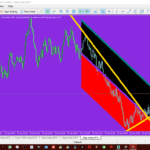Scalping is one of the most popular trading strategies used in Boom and Crash markets due to the volatility and frequent price movements these synthetic indices display. For beginners and experienced traders alike, scalping offers an opportunity to make quick, small profits by capitalizing on the frequent spikes and price changes that occur on the Boom and Crash charts.
In this article, we will explore what scalping is, how it works in the context of Boom and Crash, and provide you with a step-by-step guide to implement a successful scalping strategy.
What Is Scalping?
Scalping is a short-term trading strategy that involves making many trades over a short period to capture small price movements. Scalpers aim to accumulate small profits multiple times a day, instead of holding positions for longer periods. This strategy is especially effective in fast-moving markets like Boom and Crash, where price fluctuations can create opportunities for quick trades.
When scalping Boom and Crash, traders focus on the frequent, sharp spikes that happen within short timeframes. The idea is to enter and exit the market swiftly, capturing profits from these spikes.
Why Scalping Boom and Crash Works
Boom and Crash indices are synthetic markets that have specific characteristics, which make them suitable for scalping:
- Frequent Spikes: The primary feature of Boom and Crash is the occurrence of sudden price movements, known as spikes. These spikes can either be upward (in Crash) or downward (in Boom), and they happen frequently, creating multiple opportunities for scalpers.
- Price Reversals: After each spike, the price typically returns to a normal movement, giving traders a chance to enter the market right after the spike occurs. These reversals often happen quickly, making scalping ideal for these indices.
- Predictable Patterns: Boom and Crash indices generally follow a predictable pattern of gradual movement followed by a sharp spike, which can be useful when planning your trades.
Steps to Scalping Boom and Crash
Here’s a step-by-step guide to help you implement a successful scalping strategy on Boom and Crash:
1. Choose the Right Timeframe
Scalping in Boom and Crash works best on shorter timeframes, where price movements are more frequent and noticeable. The ideal timeframes for scalping are:
- 1-minute (M1): The 1-minute chart is perfect for fast-paced scalping. It shows quick price movements and multiple opportunities within short time periods.
- 5-minute (M5): For a bit more stability and to observe slightly larger trends, the 5-minute chart is also a popular option.
Using shorter timeframes allows you to monitor quick changes in price and make decisions on whether to enter or exit a trade almost immediately after a spike.
2. Identify Trend Direction
Even though scalping aims for small, quick profits, it’s crucial to understand the general trend of the market before entering trades. This helps to align your trades with the broader market movement, increasing your chances of success.
For Boom, the trend generally moves upward over time, while for Crash, the trend typically moves downward. However, both indices also have a lot of spikes and retracements, so understanding the direction can give you a clearer idea of when to enter or exit.
You can use trend indicators such as:
- Moving Averages (MA): A simple moving average (SMA) or exponential moving average (EMA) can help identify the current trend direction. For example, if the price is above the moving average, the trend is likely upward (Boom); if the price is below, the trend may be downward (Crash).
- Trendlines: Drawing trendlines on the chart can also help you identify when the price is respecting certain levels, which might indicate a good time to enter a trade.
3. Wait for the Spike
The key to scalping Boom and Crash is timing the spikes. For Boom, wait for a gradual upward movement followed by a downward spike, and for Crash, wait for a gradual downward movement followed by an upward spike.
To successfully scalp, you need to:
- Monitor for spikes: Wait for the price to move gradually, then look for the spike. You can use your trading platform’s alert system to notify you when the price has hit your desired levels.
- Confirm the reversal: After the spike, wait for the market to show signs of a reversal. For Boom, this means waiting for the price to start rising after a downward spike. For Crash, you should wait for the price to drop and then start rising again.
4. Set Entry and Exit Points
When scalping Boom and Crash, you’ll need to be very precise with your entry and exit points. Here’s how you can manage them:
- Entry Point: Enter the market right after the spike and once you see signs of price reversal. For example, in Boom, you might enter a sell position immediately after a sharp drop, anticipating the price will start rising again. In Crash, enter a buy position after a sharp upward spike.
- Exit Point: Scalpers look for small profits, so your exit point should be defined clearly. You can use small profit targets like 5 to 10 pips for each trade. Set a stop-loss to minimize risk, and once your target is hit, exit the trade immediately.
Make sure to use tight stop-losses and take-profits to protect your profits and limit losses. Since scalping is about quick movements, you’ll need to act fast when the price hits your predefined levels.
5. Use Indicators for Confirmation
While price action is critical for scalping, indicators can help you confirm your trades. Here are some popular ones to use for Boom and Crash:
- Relative Strength Index (RSI): This indicator measures whether an asset is overbought or oversold. For scalping, you can use RSI to confirm entry signals. For instance, an RSI below 30 may signal that Crash is oversold, and an RSI above 70 might suggest that Boom is overbought.
- Moving Average Convergence Divergence (MACD): The MACD helps you identify trend direction and momentum. A crossover of the MACD line over the signal line may indicate a buy (for Crash) or sell (for Boom).
- Bollinger Bands: This indicator helps you determine market volatility. When the price touches the lower or upper Bollinger Band, it may indicate that the price is overextended and ready for a reversal.
6. Practice Good Risk Management
Although scalping offers quick profits, it also involves quick losses if you’re not careful. To be a successful scalper, you must manage your risk effectively.
Here are some risk management tips for scalping Boom and Crash:
- Use tight stop-losses to limit your losses on each trade.
- Risk only a small percentage of your trading capital (typically 1% to 2%) per trade.
- Avoid overtrading: Since scalping involves many trades, it can be tempting to trade too frequently. Stick to your strategy and avoid chasing the market.
7. Stay Calm and Be Disciplined
Scalping requires a lot of focus and quick decision-making. The market can move fast, and it’s easy to get caught up in the excitement. However, staying calm and disciplined is key. Stick to your plan, avoid emotional trading, and don’t rush into trades.
Make sure to take breaks and avoid trading for extended hours. Scalping for too long can lead to mental fatigue, which might affect your trading decisions.
Conclusion
Scalping Boom and Crash can be an effective way to make consistent profits if done correctly. The key to successful scalping lies in mastering market timing, using technical analysis, and applying strict risk management. By following the steps outlined in this article—choosing the right timeframe, understanding the market trends, timing your entry and exit points, and using indicators for confirmation—you can significantly improve your chances of success in Boom and Crash scalping.
Remember, practice makes perfect. Start by using a demo account to hone your skills and refine your strategy, and always trade with discipline and patience.







